Business Law Assignment: Contract Formation and Exclusion Clauses
VerifiedAdded on 2020/05/28
|12
|2806
|564
Homework Assignment
AI Summary
This business law assignment analyzes two scenarios using the IRAC (Issue, Rule, Application, Conclusion) method. Part 1 examines whether a contract was formed between Sam and Danny, considering offer, acceptance, and revocation through email and phone calls, referencing cases like Partridge v Crittenden, Hyde v Wrench, and Dickinson v Dodds. Part 2 focuses on an exclusion clause on a docket received by Jane from Laundry Today Pty Ltd. It addresses whether the clause is an exclusion clause, if it was effectively incorporated into the contract, if a representative's reply had legal effect, and if the clause's wording was clear. The analysis considers misrepresentation, referencing cases such as L'Estrange v Graucob and Curtis v Chemical Cleaning and Dyeing Co, and concludes whether Jane has grounds to claim for damages.

Paraphrase This Document
Need a fresh take? Get an instant paraphrase of this document with our AI Paraphraser
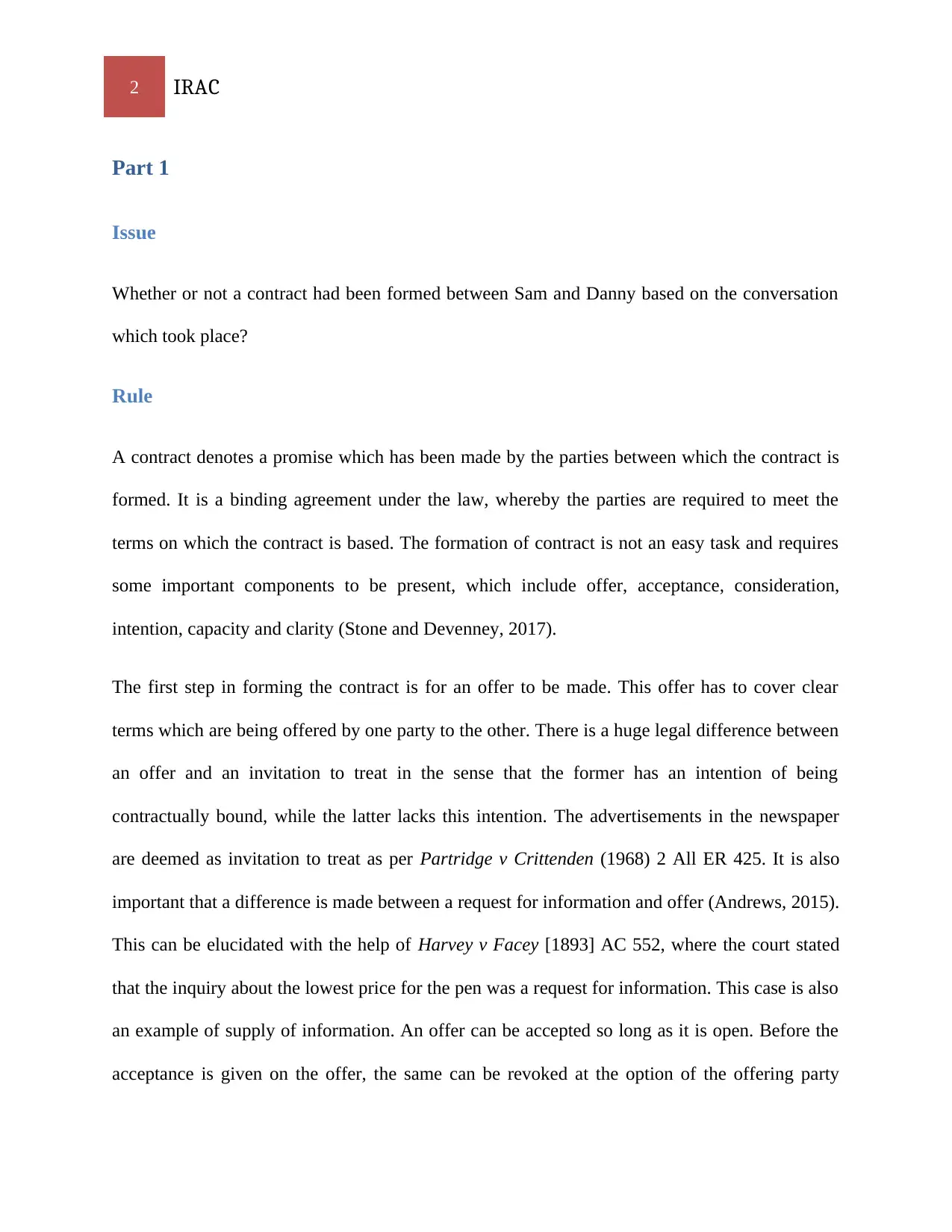
2 IRAC
Part 1
Issue
Whether or not a contract had been formed between Sam and Danny based on the conversation
which took place?
Rule
A contract denotes a promise which has been made by the parties between which the contract is
formed. It is a binding agreement under the law, whereby the parties are required to meet the
terms on which the contract is based. The formation of contract is not an easy task and requires
some important components to be present, which include offer, acceptance, consideration,
intention, capacity and clarity (Stone and Devenney, 2017).
The first step in forming the contract is for an offer to be made. This offer has to cover clear
terms which are being offered by one party to the other. There is a huge legal difference between
an offer and an invitation to treat in the sense that the former has an intention of being
contractually bound, while the latter lacks this intention. The advertisements in the newspaper
are deemed as invitation to treat as per Partridge v Crittenden (1968) 2 All ER 425. It is also
important that a difference is made between a request for information and offer (Andrews, 2015).
This can be elucidated with the help of Harvey v Facey [1893] AC 552, where the court stated
that the inquiry about the lowest price for the pen was a request for information. This case is also
an example of supply of information. An offer can be accepted so long as it is open. Before the
acceptance is given on the offer, the same can be revoked at the option of the offering party
Part 1
Issue
Whether or not a contract had been formed between Sam and Danny based on the conversation
which took place?
Rule
A contract denotes a promise which has been made by the parties between which the contract is
formed. It is a binding agreement under the law, whereby the parties are required to meet the
terms on which the contract is based. The formation of contract is not an easy task and requires
some important components to be present, which include offer, acceptance, consideration,
intention, capacity and clarity (Stone and Devenney, 2017).
The first step in forming the contract is for an offer to be made. This offer has to cover clear
terms which are being offered by one party to the other. There is a huge legal difference between
an offer and an invitation to treat in the sense that the former has an intention of being
contractually bound, while the latter lacks this intention. The advertisements in the newspaper
are deemed as invitation to treat as per Partridge v Crittenden (1968) 2 All ER 425. It is also
important that a difference is made between a request for information and offer (Andrews, 2015).
This can be elucidated with the help of Harvey v Facey [1893] AC 552, where the court stated
that the inquiry about the lowest price for the pen was a request for information. This case is also
an example of supply of information. An offer can be accepted so long as it is open. Before the
acceptance is given on the offer, the same can be revoked at the option of the offering party
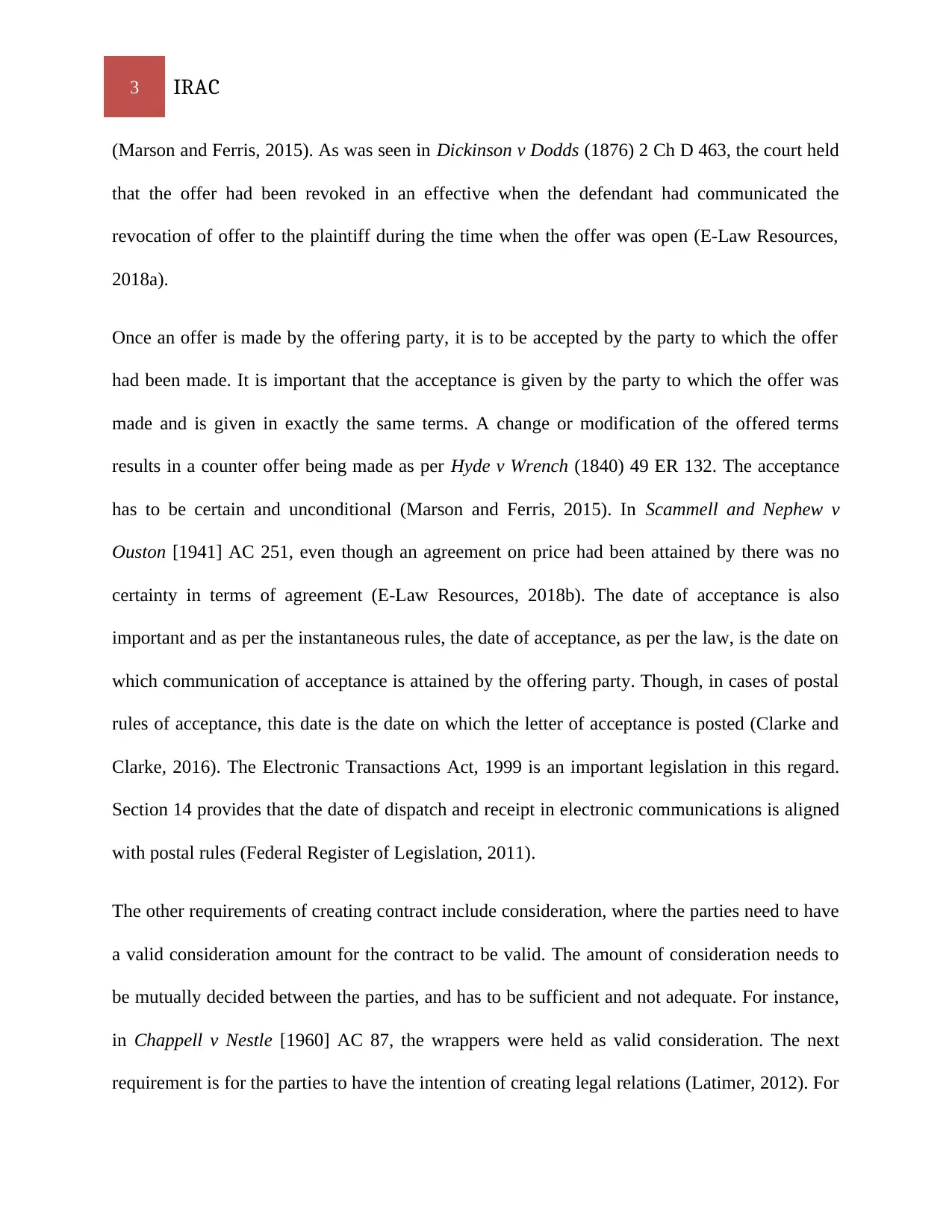
3 IRAC
(Marson and Ferris, 2015). As was seen in Dickinson v Dodds (1876) 2 Ch D 463, the court held
that the offer had been revoked in an effective when the defendant had communicated the
revocation of offer to the plaintiff during the time when the offer was open (E-Law Resources,
2018a).
Once an offer is made by the offering party, it is to be accepted by the party to which the offer
had been made. It is important that the acceptance is given by the party to which the offer was
made and is given in exactly the same terms. A change or modification of the offered terms
results in a counter offer being made as per Hyde v Wrench (1840) 49 ER 132. The acceptance
has to be certain and unconditional (Marson and Ferris, 2015). In Scammell and Nephew v
Ouston [1941] AC 251, even though an agreement on price had been attained by there was no
certainty in terms of agreement (E-Law Resources, 2018b). The date of acceptance is also
important and as per the instantaneous rules, the date of acceptance, as per the law, is the date on
which communication of acceptance is attained by the offering party. Though, in cases of postal
rules of acceptance, this date is the date on which the letter of acceptance is posted (Clarke and
Clarke, 2016). The Electronic Transactions Act, 1999 is an important legislation in this regard.
Section 14 provides that the date of dispatch and receipt in electronic communications is aligned
with postal rules (Federal Register of Legislation, 2011).
The other requirements of creating contract include consideration, where the parties need to have
a valid consideration amount for the contract to be valid. The amount of consideration needs to
be mutually decided between the parties, and has to be sufficient and not adequate. For instance,
in Chappell v Nestle [1960] AC 87, the wrappers were held as valid consideration. The next
requirement is for the parties to have the intention of creating legal relations (Latimer, 2012). For
(Marson and Ferris, 2015). As was seen in Dickinson v Dodds (1876) 2 Ch D 463, the court held
that the offer had been revoked in an effective when the defendant had communicated the
revocation of offer to the plaintiff during the time when the offer was open (E-Law Resources,
2018a).
Once an offer is made by the offering party, it is to be accepted by the party to which the offer
had been made. It is important that the acceptance is given by the party to which the offer was
made and is given in exactly the same terms. A change or modification of the offered terms
results in a counter offer being made as per Hyde v Wrench (1840) 49 ER 132. The acceptance
has to be certain and unconditional (Marson and Ferris, 2015). In Scammell and Nephew v
Ouston [1941] AC 251, even though an agreement on price had been attained by there was no
certainty in terms of agreement (E-Law Resources, 2018b). The date of acceptance is also
important and as per the instantaneous rules, the date of acceptance, as per the law, is the date on
which communication of acceptance is attained by the offering party. Though, in cases of postal
rules of acceptance, this date is the date on which the letter of acceptance is posted (Clarke and
Clarke, 2016). The Electronic Transactions Act, 1999 is an important legislation in this regard.
Section 14 provides that the date of dispatch and receipt in electronic communications is aligned
with postal rules (Federal Register of Legislation, 2011).
The other requirements of creating contract include consideration, where the parties need to have
a valid consideration amount for the contract to be valid. The amount of consideration needs to
be mutually decided between the parties, and has to be sufficient and not adequate. For instance,
in Chappell v Nestle [1960] AC 87, the wrappers were held as valid consideration. The next
requirement is for the parties to have the intention of creating legal relations (Latimer, 2012). For
⊘ This is a preview!⊘
Do you want full access?
Subscribe today to unlock all pages.

Trusted by 1+ million students worldwide
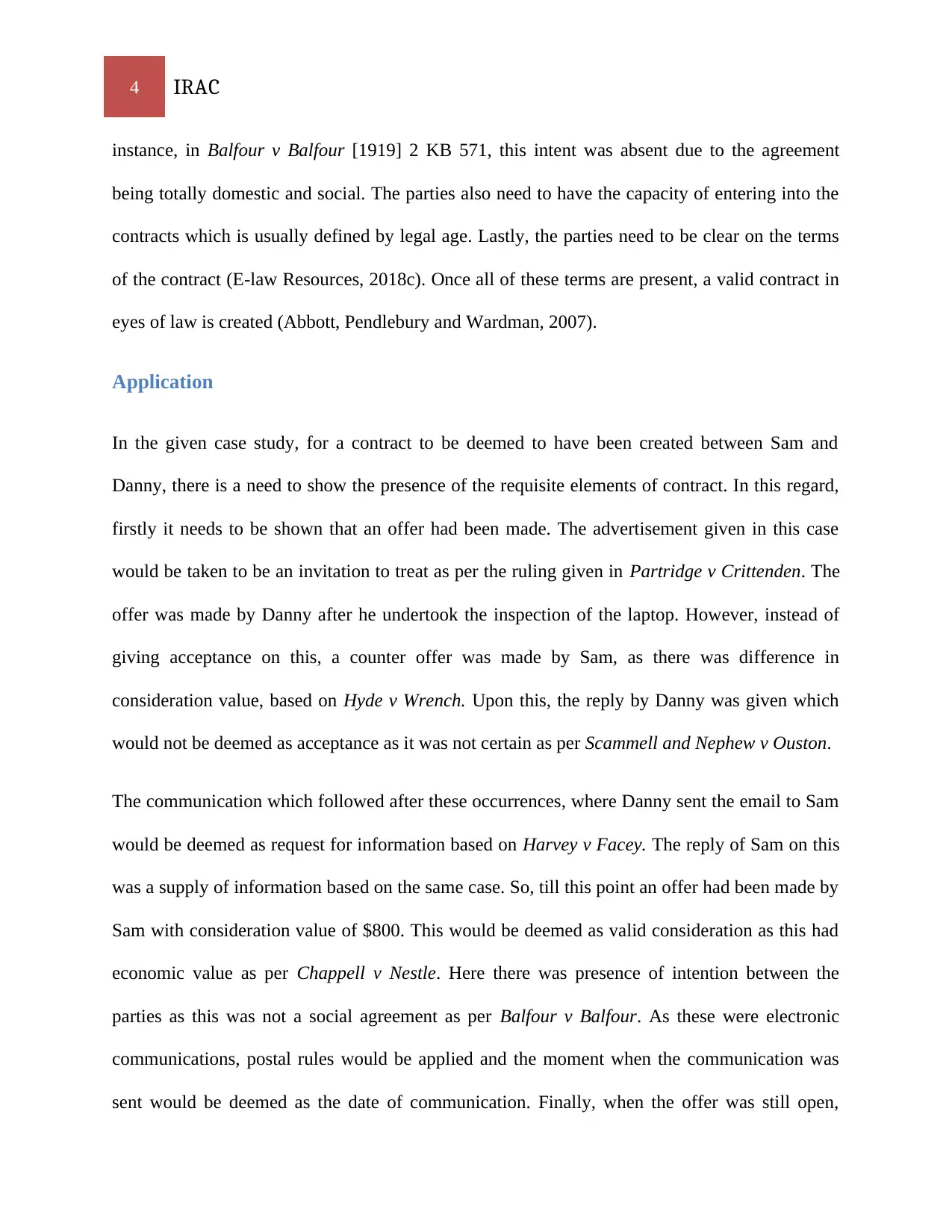
4 IRAC
instance, in Balfour v Balfour [1919] 2 KB 571, this intent was absent due to the agreement
being totally domestic and social. The parties also need to have the capacity of entering into the
contracts which is usually defined by legal age. Lastly, the parties need to be clear on the terms
of the contract (E-law Resources, 2018c). Once all of these terms are present, a valid contract in
eyes of law is created (Abbott, Pendlebury and Wardman, 2007).
Application
In the given case study, for a contract to be deemed to have been created between Sam and
Danny, there is a need to show the presence of the requisite elements of contract. In this regard,
firstly it needs to be shown that an offer had been made. The advertisement given in this case
would be taken to be an invitation to treat as per the ruling given in Partridge v Crittenden. The
offer was made by Danny after he undertook the inspection of the laptop. However, instead of
giving acceptance on this, a counter offer was made by Sam, as there was difference in
consideration value, based on Hyde v Wrench. Upon this, the reply by Danny was given which
would not be deemed as acceptance as it was not certain as per Scammell and Nephew v Ouston.
The communication which followed after these occurrences, where Danny sent the email to Sam
would be deemed as request for information based on Harvey v Facey. The reply of Sam on this
was a supply of information based on the same case. So, till this point an offer had been made by
Sam with consideration value of $800. This would be deemed as valid consideration as this had
economic value as per Chappell v Nestle. Here there was presence of intention between the
parties as this was not a social agreement as per Balfour v Balfour. As these were electronic
communications, postal rules would be applied and the moment when the communication was
sent would be deemed as the date of communication. Finally, when the offer was still open,
instance, in Balfour v Balfour [1919] 2 KB 571, this intent was absent due to the agreement
being totally domestic and social. The parties also need to have the capacity of entering into the
contracts which is usually defined by legal age. Lastly, the parties need to be clear on the terms
of the contract (E-law Resources, 2018c). Once all of these terms are present, a valid contract in
eyes of law is created (Abbott, Pendlebury and Wardman, 2007).
Application
In the given case study, for a contract to be deemed to have been created between Sam and
Danny, there is a need to show the presence of the requisite elements of contract. In this regard,
firstly it needs to be shown that an offer had been made. The advertisement given in this case
would be taken to be an invitation to treat as per the ruling given in Partridge v Crittenden. The
offer was made by Danny after he undertook the inspection of the laptop. However, instead of
giving acceptance on this, a counter offer was made by Sam, as there was difference in
consideration value, based on Hyde v Wrench. Upon this, the reply by Danny was given which
would not be deemed as acceptance as it was not certain as per Scammell and Nephew v Ouston.
The communication which followed after these occurrences, where Danny sent the email to Sam
would be deemed as request for information based on Harvey v Facey. The reply of Sam on this
was a supply of information based on the same case. So, till this point an offer had been made by
Sam with consideration value of $800. This would be deemed as valid consideration as this had
economic value as per Chappell v Nestle. Here there was presence of intention between the
parties as this was not a social agreement as per Balfour v Balfour. As these were electronic
communications, postal rules would be applied and the moment when the communication was
sent would be deemed as the date of communication. Finally, when the offer was still open,
Paraphrase This Document
Need a fresh take? Get an instant paraphrase of this document with our AI Paraphraser

5 IRAC
based on Dickinson v Dodds, the offer was revoked by Sam through email and call. Thus, no
acceptance had been given in this case by Danny and before the same could be done, the offer
was validly revoked.
Conclusion
Thus, based on this situation, it can be concluded that no contract had been formed between the
two parties.
Part 2(a)
Issue
The issue of this case revolves around the type of clause found on the docket received by Jane.
Rule
The exclusion clauses are such terms in the contract which have the capability of restricting or
limiting the liabilities of the parties in the contract (McKendrick and Liu, 2015).
Application
The clause covered at the back of the docket was an exclusion clause as it had the capability of
restricting the responsibility of Laundry Today Pty Ltd in case of any loss or damage to the
clothing items.
Conclusion
Thus, the clause printed at the back of docket was an exclusion clause.
based on Dickinson v Dodds, the offer was revoked by Sam through email and call. Thus, no
acceptance had been given in this case by Danny and before the same could be done, the offer
was validly revoked.
Conclusion
Thus, based on this situation, it can be concluded that no contract had been formed between the
two parties.
Part 2(a)
Issue
The issue of this case revolves around the type of clause found on the docket received by Jane.
Rule
The exclusion clauses are such terms in the contract which have the capability of restricting or
limiting the liabilities of the parties in the contract (McKendrick and Liu, 2015).
Application
The clause covered at the back of the docket was an exclusion clause as it had the capability of
restricting the responsibility of Laundry Today Pty Ltd in case of any loss or damage to the
clothing items.
Conclusion
Thus, the clause printed at the back of docket was an exclusion clause.
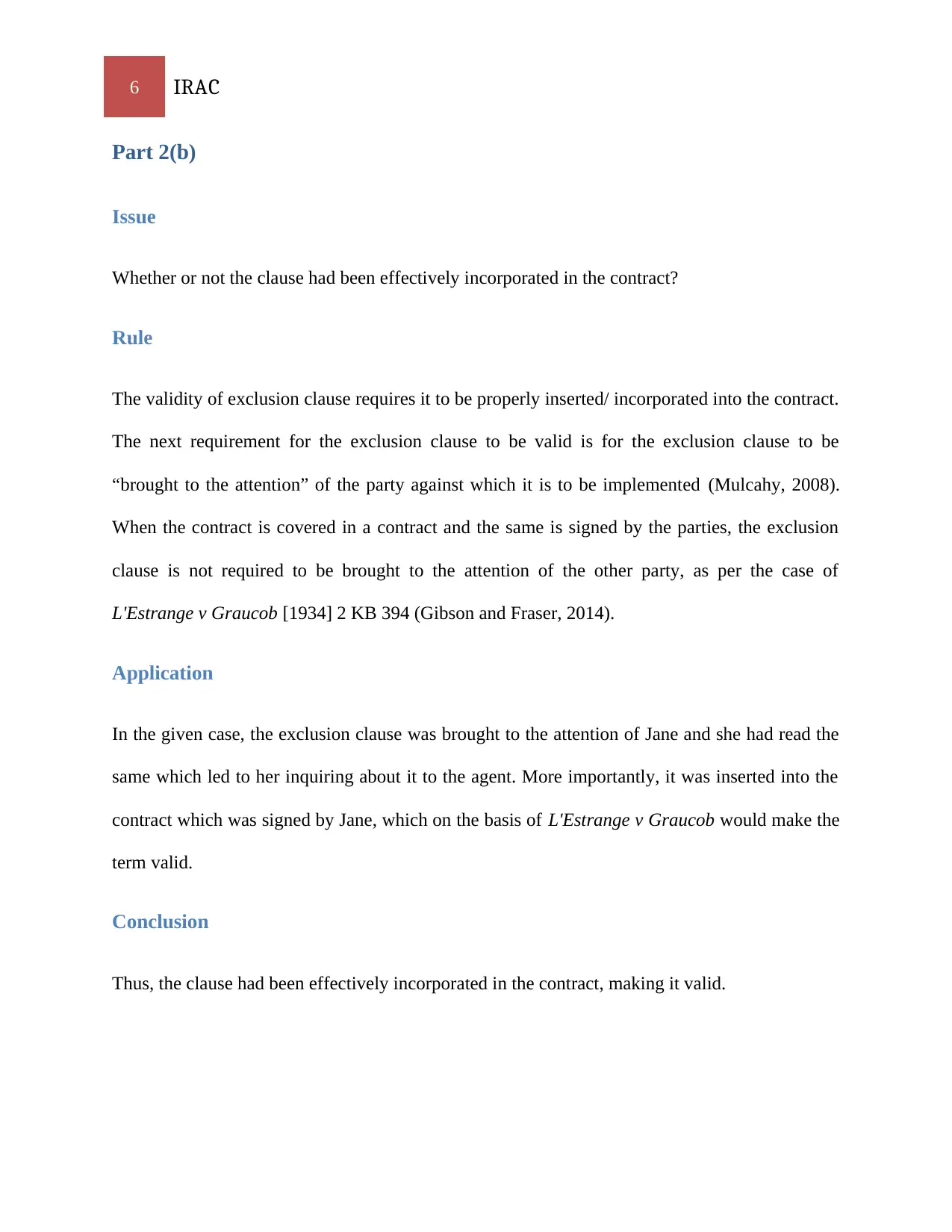
6 IRAC
Part 2(b)
Issue
Whether or not the clause had been effectively incorporated in the contract?
Rule
The validity of exclusion clause requires it to be properly inserted/ incorporated into the contract.
The next requirement for the exclusion clause to be valid is for the exclusion clause to be
“brought to the attention” of the party against which it is to be implemented (Mulcahy, 2008).
When the contract is covered in a contract and the same is signed by the parties, the exclusion
clause is not required to be brought to the attention of the other party, as per the case of
L'Estrange v Graucob [1934] 2 KB 394 (Gibson and Fraser, 2014).
Application
In the given case, the exclusion clause was brought to the attention of Jane and she had read the
same which led to her inquiring about it to the agent. More importantly, it was inserted into the
contract which was signed by Jane, which on the basis of L'Estrange v Graucob would make the
term valid.
Conclusion
Thus, the clause had been effectively incorporated in the contract, making it valid.
Part 2(b)
Issue
Whether or not the clause had been effectively incorporated in the contract?
Rule
The validity of exclusion clause requires it to be properly inserted/ incorporated into the contract.
The next requirement for the exclusion clause to be valid is for the exclusion clause to be
“brought to the attention” of the party against which it is to be implemented (Mulcahy, 2008).
When the contract is covered in a contract and the same is signed by the parties, the exclusion
clause is not required to be brought to the attention of the other party, as per the case of
L'Estrange v Graucob [1934] 2 KB 394 (Gibson and Fraser, 2014).
Application
In the given case, the exclusion clause was brought to the attention of Jane and she had read the
same which led to her inquiring about it to the agent. More importantly, it was inserted into the
contract which was signed by Jane, which on the basis of L'Estrange v Graucob would make the
term valid.
Conclusion
Thus, the clause had been effectively incorporated in the contract, making it valid.
⊘ This is a preview!⊘
Do you want full access?
Subscribe today to unlock all pages.

Trusted by 1+ million students worldwide
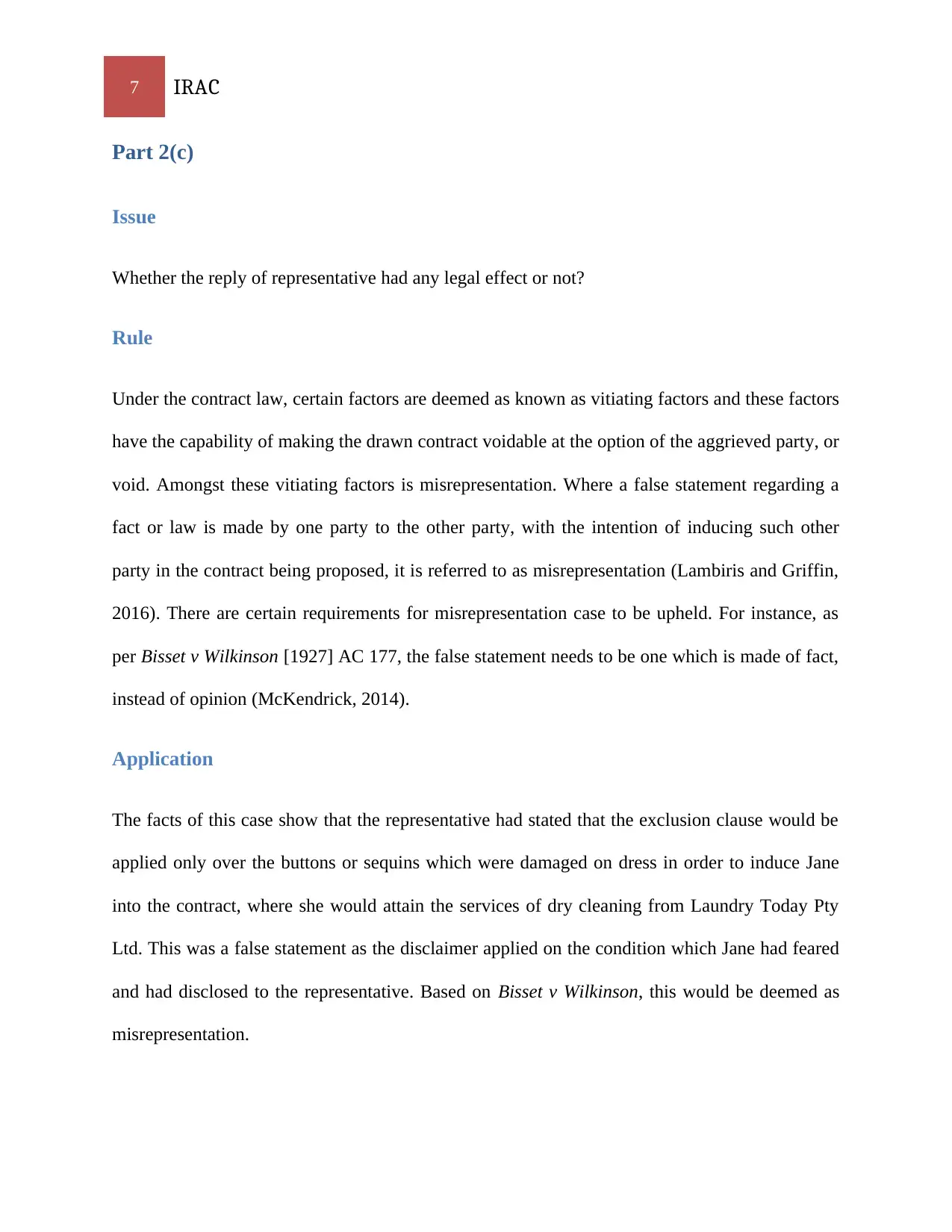
7 IRAC
Part 2(c)
Issue
Whether the reply of representative had any legal effect or not?
Rule
Under the contract law, certain factors are deemed as known as vitiating factors and these factors
have the capability of making the drawn contract voidable at the option of the aggrieved party, or
void. Amongst these vitiating factors is misrepresentation. Where a false statement regarding a
fact or law is made by one party to the other party, with the intention of inducing such other
party in the contract being proposed, it is referred to as misrepresentation (Lambiris and Griffin,
2016). There are certain requirements for misrepresentation case to be upheld. For instance, as
per Bisset v Wilkinson [1927] AC 177, the false statement needs to be one which is made of fact,
instead of opinion (McKendrick, 2014).
Application
The facts of this case show that the representative had stated that the exclusion clause would be
applied only over the buttons or sequins which were damaged on dress in order to induce Jane
into the contract, where she would attain the services of dry cleaning from Laundry Today Pty
Ltd. This was a false statement as the disclaimer applied on the condition which Jane had feared
and had disclosed to the representative. Based on Bisset v Wilkinson, this would be deemed as
misrepresentation.
Part 2(c)
Issue
Whether the reply of representative had any legal effect or not?
Rule
Under the contract law, certain factors are deemed as known as vitiating factors and these factors
have the capability of making the drawn contract voidable at the option of the aggrieved party, or
void. Amongst these vitiating factors is misrepresentation. Where a false statement regarding a
fact or law is made by one party to the other party, with the intention of inducing such other
party in the contract being proposed, it is referred to as misrepresentation (Lambiris and Griffin,
2016). There are certain requirements for misrepresentation case to be upheld. For instance, as
per Bisset v Wilkinson [1927] AC 177, the false statement needs to be one which is made of fact,
instead of opinion (McKendrick, 2014).
Application
The facts of this case show that the representative had stated that the exclusion clause would be
applied only over the buttons or sequins which were damaged on dress in order to induce Jane
into the contract, where she would attain the services of dry cleaning from Laundry Today Pty
Ltd. This was a false statement as the disclaimer applied on the condition which Jane had feared
and had disclosed to the representative. Based on Bisset v Wilkinson, this would be deemed as
misrepresentation.
Paraphrase This Document
Need a fresh take? Get an instant paraphrase of this document with our AI Paraphraser
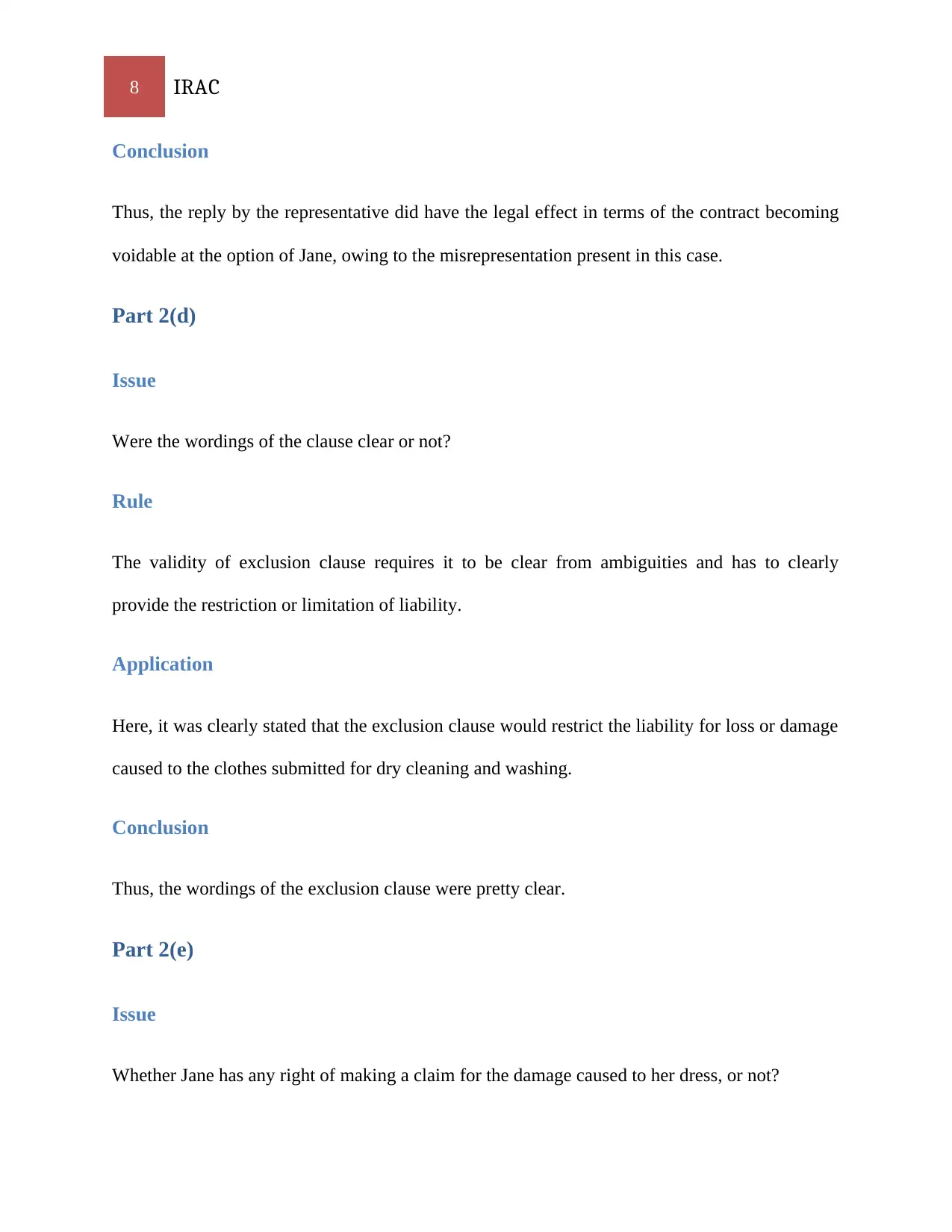
8 IRAC
Conclusion
Thus, the reply by the representative did have the legal effect in terms of the contract becoming
voidable at the option of Jane, owing to the misrepresentation present in this case.
Part 2(d)
Issue
Were the wordings of the clause clear or not?
Rule
The validity of exclusion clause requires it to be clear from ambiguities and has to clearly
provide the restriction or limitation of liability.
Application
Here, it was clearly stated that the exclusion clause would restrict the liability for loss or damage
caused to the clothes submitted for dry cleaning and washing.
Conclusion
Thus, the wordings of the exclusion clause were pretty clear.
Part 2(e)
Issue
Whether Jane has any right of making a claim for the damage caused to her dress, or not?
Conclusion
Thus, the reply by the representative did have the legal effect in terms of the contract becoming
voidable at the option of Jane, owing to the misrepresentation present in this case.
Part 2(d)
Issue
Were the wordings of the clause clear or not?
Rule
The validity of exclusion clause requires it to be clear from ambiguities and has to clearly
provide the restriction or limitation of liability.
Application
Here, it was clearly stated that the exclusion clause would restrict the liability for loss or damage
caused to the clothes submitted for dry cleaning and washing.
Conclusion
Thus, the wordings of the exclusion clause were pretty clear.
Part 2(e)
Issue
Whether Jane has any right of making a claim for the damage caused to her dress, or not?
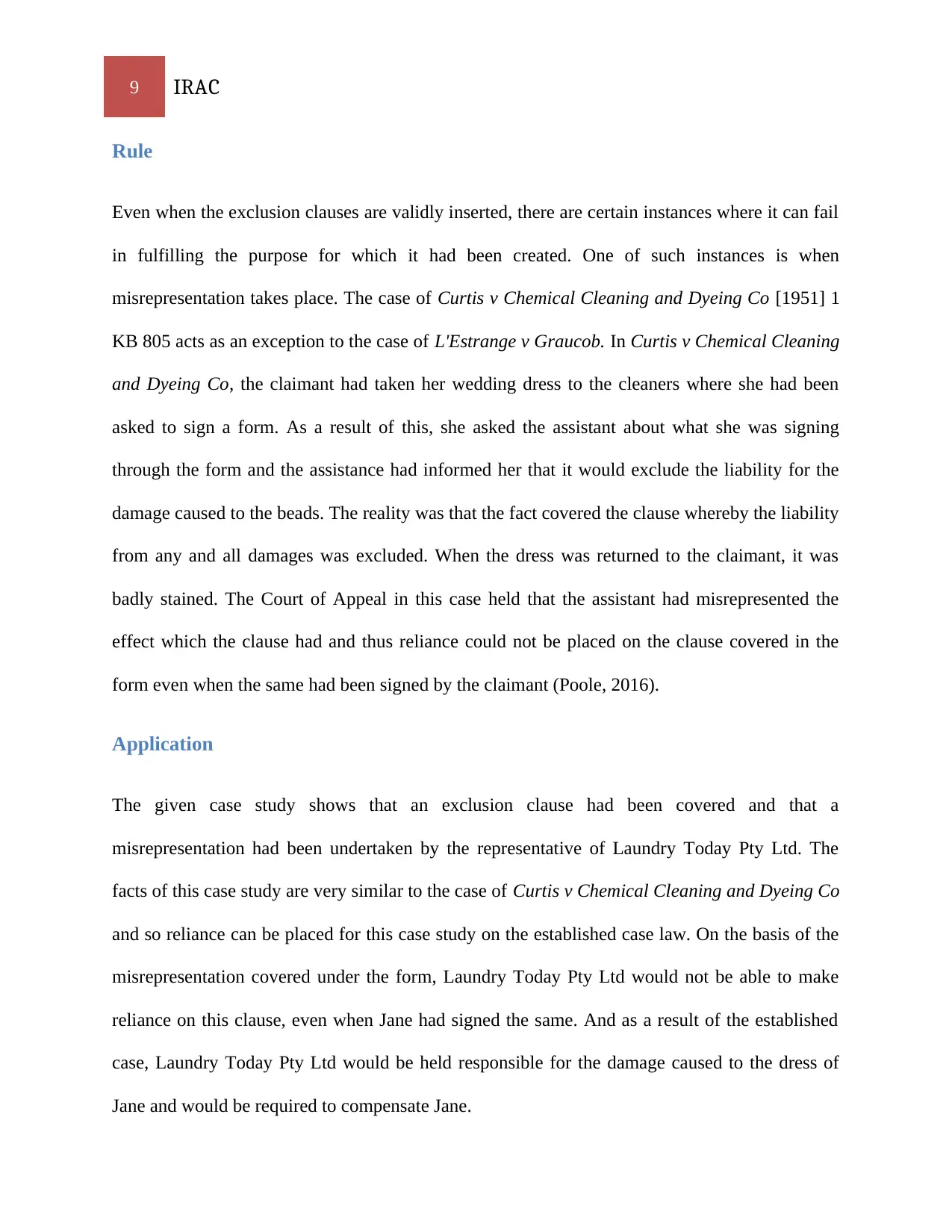
9 IRAC
Rule
Even when the exclusion clauses are validly inserted, there are certain instances where it can fail
in fulfilling the purpose for which it had been created. One of such instances is when
misrepresentation takes place. The case of Curtis v Chemical Cleaning and Dyeing Co [1951] 1
KB 805 acts as an exception to the case of L'Estrange v Graucob. In Curtis v Chemical Cleaning
and Dyeing Co, the claimant had taken her wedding dress to the cleaners where she had been
asked to sign a form. As a result of this, she asked the assistant about what she was signing
through the form and the assistance had informed her that it would exclude the liability for the
damage caused to the beads. The reality was that the fact covered the clause whereby the liability
from any and all damages was excluded. When the dress was returned to the claimant, it was
badly stained. The Court of Appeal in this case held that the assistant had misrepresented the
effect which the clause had and thus reliance could not be placed on the clause covered in the
form even when the same had been signed by the claimant (Poole, 2016).
Application
The given case study shows that an exclusion clause had been covered and that a
misrepresentation had been undertaken by the representative of Laundry Today Pty Ltd. The
facts of this case study are very similar to the case of Curtis v Chemical Cleaning and Dyeing Co
and so reliance can be placed for this case study on the established case law. On the basis of the
misrepresentation covered under the form, Laundry Today Pty Ltd would not be able to make
reliance on this clause, even when Jane had signed the same. And as a result of the established
case, Laundry Today Pty Ltd would be held responsible for the damage caused to the dress of
Jane and would be required to compensate Jane.
Rule
Even when the exclusion clauses are validly inserted, there are certain instances where it can fail
in fulfilling the purpose for which it had been created. One of such instances is when
misrepresentation takes place. The case of Curtis v Chemical Cleaning and Dyeing Co [1951] 1
KB 805 acts as an exception to the case of L'Estrange v Graucob. In Curtis v Chemical Cleaning
and Dyeing Co, the claimant had taken her wedding dress to the cleaners where she had been
asked to sign a form. As a result of this, she asked the assistant about what she was signing
through the form and the assistance had informed her that it would exclude the liability for the
damage caused to the beads. The reality was that the fact covered the clause whereby the liability
from any and all damages was excluded. When the dress was returned to the claimant, it was
badly stained. The Court of Appeal in this case held that the assistant had misrepresented the
effect which the clause had and thus reliance could not be placed on the clause covered in the
form even when the same had been signed by the claimant (Poole, 2016).
Application
The given case study shows that an exclusion clause had been covered and that a
misrepresentation had been undertaken by the representative of Laundry Today Pty Ltd. The
facts of this case study are very similar to the case of Curtis v Chemical Cleaning and Dyeing Co
and so reliance can be placed for this case study on the established case law. On the basis of the
misrepresentation covered under the form, Laundry Today Pty Ltd would not be able to make
reliance on this clause, even when Jane had signed the same. And as a result of the established
case, Laundry Today Pty Ltd would be held responsible for the damage caused to the dress of
Jane and would be required to compensate Jane.
⊘ This is a preview!⊘
Do you want full access?
Subscribe today to unlock all pages.

Trusted by 1+ million students worldwide
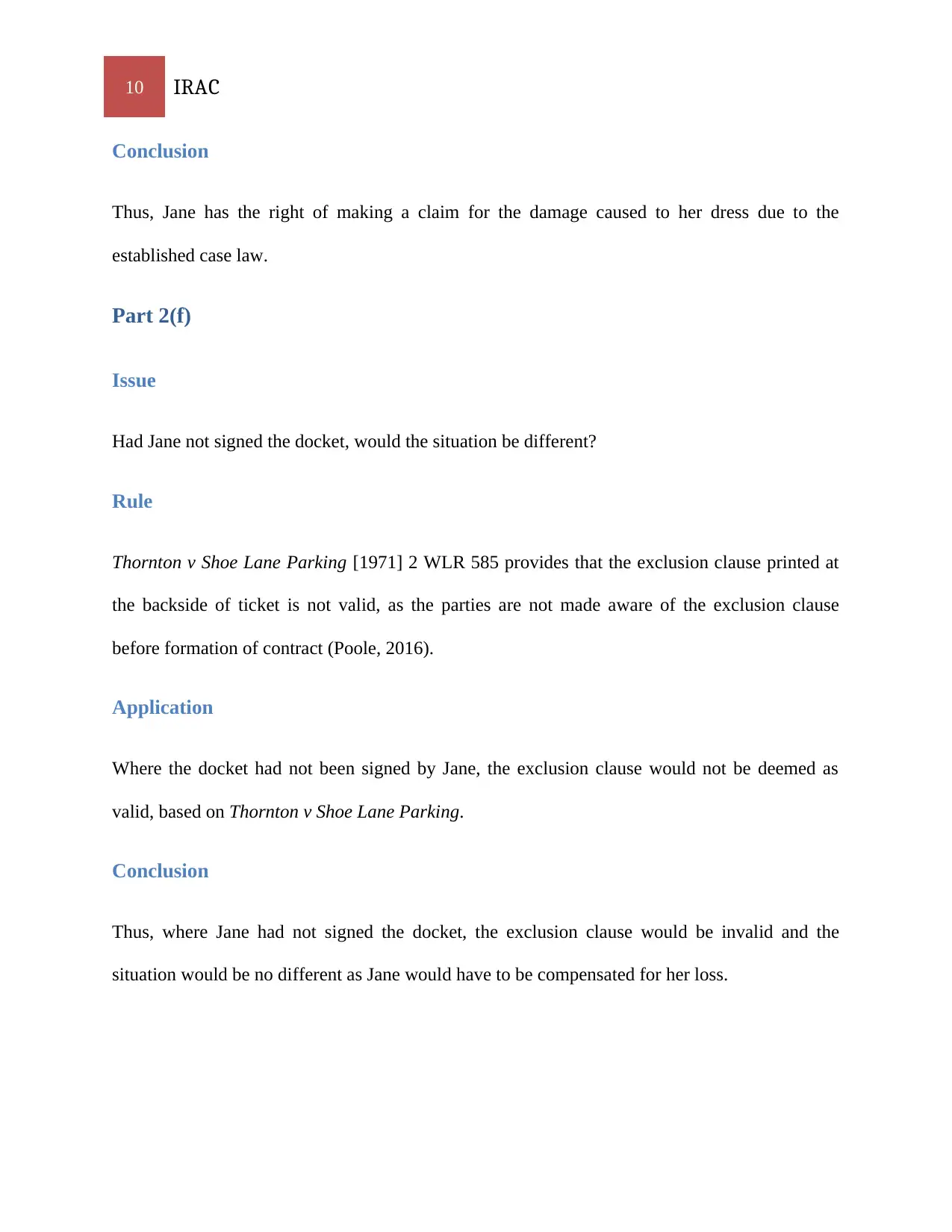
10 IRAC
Conclusion
Thus, Jane has the right of making a claim for the damage caused to her dress due to the
established case law.
Part 2(f)
Issue
Had Jane not signed the docket, would the situation be different?
Rule
Thornton v Shoe Lane Parking [1971] 2 WLR 585 provides that the exclusion clause printed at
the backside of ticket is not valid, as the parties are not made aware of the exclusion clause
before formation of contract (Poole, 2016).
Application
Where the docket had not been signed by Jane, the exclusion clause would not be deemed as
valid, based on Thornton v Shoe Lane Parking.
Conclusion
Thus, where Jane had not signed the docket, the exclusion clause would be invalid and the
situation would be no different as Jane would have to be compensated for her loss.
Conclusion
Thus, Jane has the right of making a claim for the damage caused to her dress due to the
established case law.
Part 2(f)
Issue
Had Jane not signed the docket, would the situation be different?
Rule
Thornton v Shoe Lane Parking [1971] 2 WLR 585 provides that the exclusion clause printed at
the backside of ticket is not valid, as the parties are not made aware of the exclusion clause
before formation of contract (Poole, 2016).
Application
Where the docket had not been signed by Jane, the exclusion clause would not be deemed as
valid, based on Thornton v Shoe Lane Parking.
Conclusion
Thus, where Jane had not signed the docket, the exclusion clause would be invalid and the
situation would be no different as Jane would have to be compensated for her loss.
Paraphrase This Document
Need a fresh take? Get an instant paraphrase of this document with our AI Paraphraser
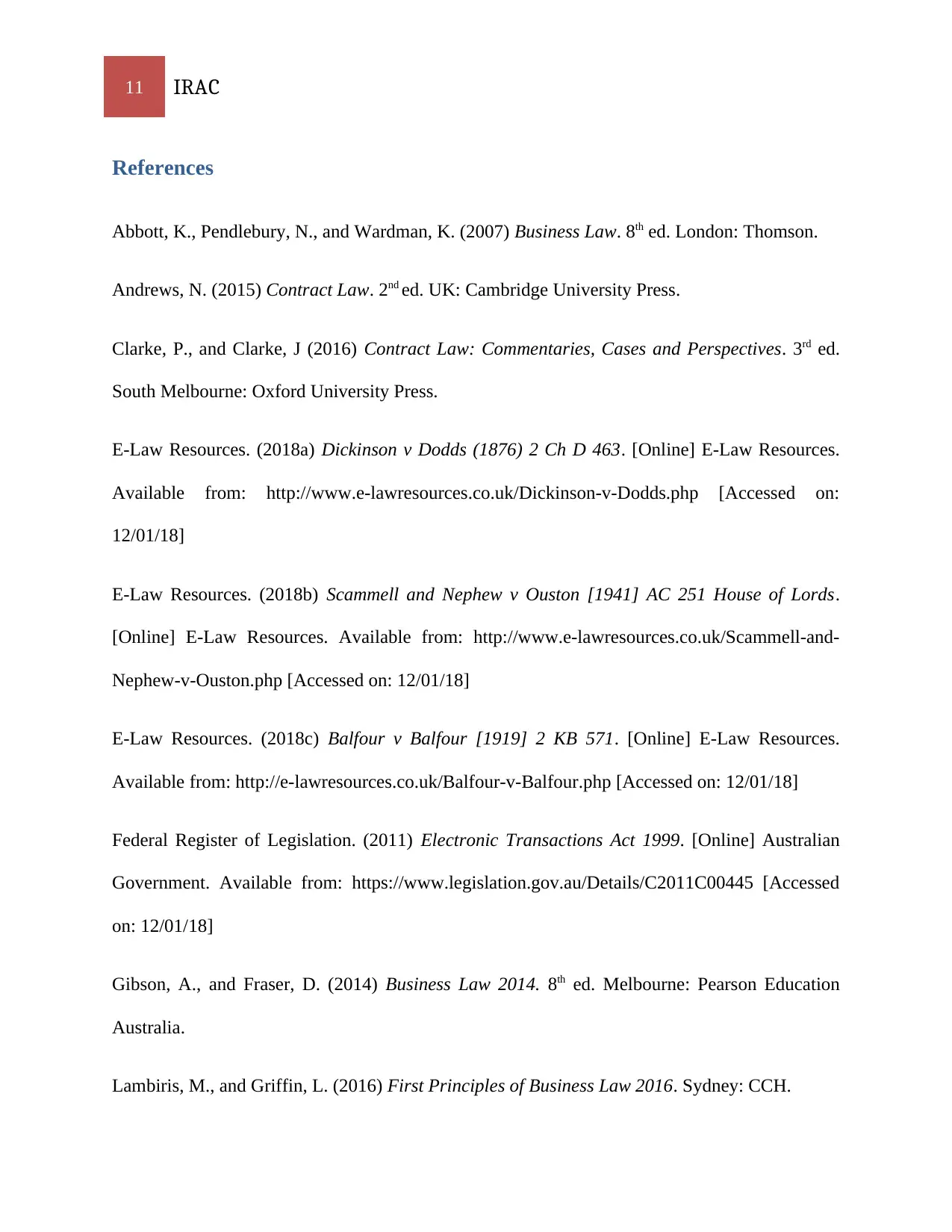
11 IRAC
References
Abbott, K., Pendlebury, N., and Wardman, K. (2007) Business Law. 8th ed. London: Thomson.
Andrews, N. (2015) Contract Law. 2nd ed. UK: Cambridge University Press.
Clarke, P., and Clarke, J (2016) Contract Law: Commentaries, Cases and Perspectives. 3rd ed.
South Melbourne: Oxford University Press.
E-Law Resources. (2018a) Dickinson v Dodds (1876) 2 Ch D 463. [Online] E-Law Resources.
Available from: http://www.e-lawresources.co.uk/Dickinson-v-Dodds.php [Accessed on:
12/01/18]
E-Law Resources. (2018b) Scammell and Nephew v Ouston [1941] AC 251 House of Lords.
[Online] E-Law Resources. Available from: http://www.e-lawresources.co.uk/Scammell-and-
Nephew-v-Ouston.php [Accessed on: 12/01/18]
E-Law Resources. (2018c) Balfour v Balfour [1919] 2 KB 571. [Online] E-Law Resources.
Available from: http://e-lawresources.co.uk/Balfour-v-Balfour.php [Accessed on: 12/01/18]
Federal Register of Legislation. (2011) Electronic Transactions Act 1999. [Online] Australian
Government. Available from: https://www.legislation.gov.au/Details/C2011C00445 [Accessed
on: 12/01/18]
Gibson, A., and Fraser, D. (2014) Business Law 2014. 8th ed. Melbourne: Pearson Education
Australia.
Lambiris, M., and Griffin, L. (2016) First Principles of Business Law 2016. Sydney: CCH.
References
Abbott, K., Pendlebury, N., and Wardman, K. (2007) Business Law. 8th ed. London: Thomson.
Andrews, N. (2015) Contract Law. 2nd ed. UK: Cambridge University Press.
Clarke, P., and Clarke, J (2016) Contract Law: Commentaries, Cases and Perspectives. 3rd ed.
South Melbourne: Oxford University Press.
E-Law Resources. (2018a) Dickinson v Dodds (1876) 2 Ch D 463. [Online] E-Law Resources.
Available from: http://www.e-lawresources.co.uk/Dickinson-v-Dodds.php [Accessed on:
12/01/18]
E-Law Resources. (2018b) Scammell and Nephew v Ouston [1941] AC 251 House of Lords.
[Online] E-Law Resources. Available from: http://www.e-lawresources.co.uk/Scammell-and-
Nephew-v-Ouston.php [Accessed on: 12/01/18]
E-Law Resources. (2018c) Balfour v Balfour [1919] 2 KB 571. [Online] E-Law Resources.
Available from: http://e-lawresources.co.uk/Balfour-v-Balfour.php [Accessed on: 12/01/18]
Federal Register of Legislation. (2011) Electronic Transactions Act 1999. [Online] Australian
Government. Available from: https://www.legislation.gov.au/Details/C2011C00445 [Accessed
on: 12/01/18]
Gibson, A., and Fraser, D. (2014) Business Law 2014. 8th ed. Melbourne: Pearson Education
Australia.
Lambiris, M., and Griffin, L. (2016) First Principles of Business Law 2016. Sydney: CCH.
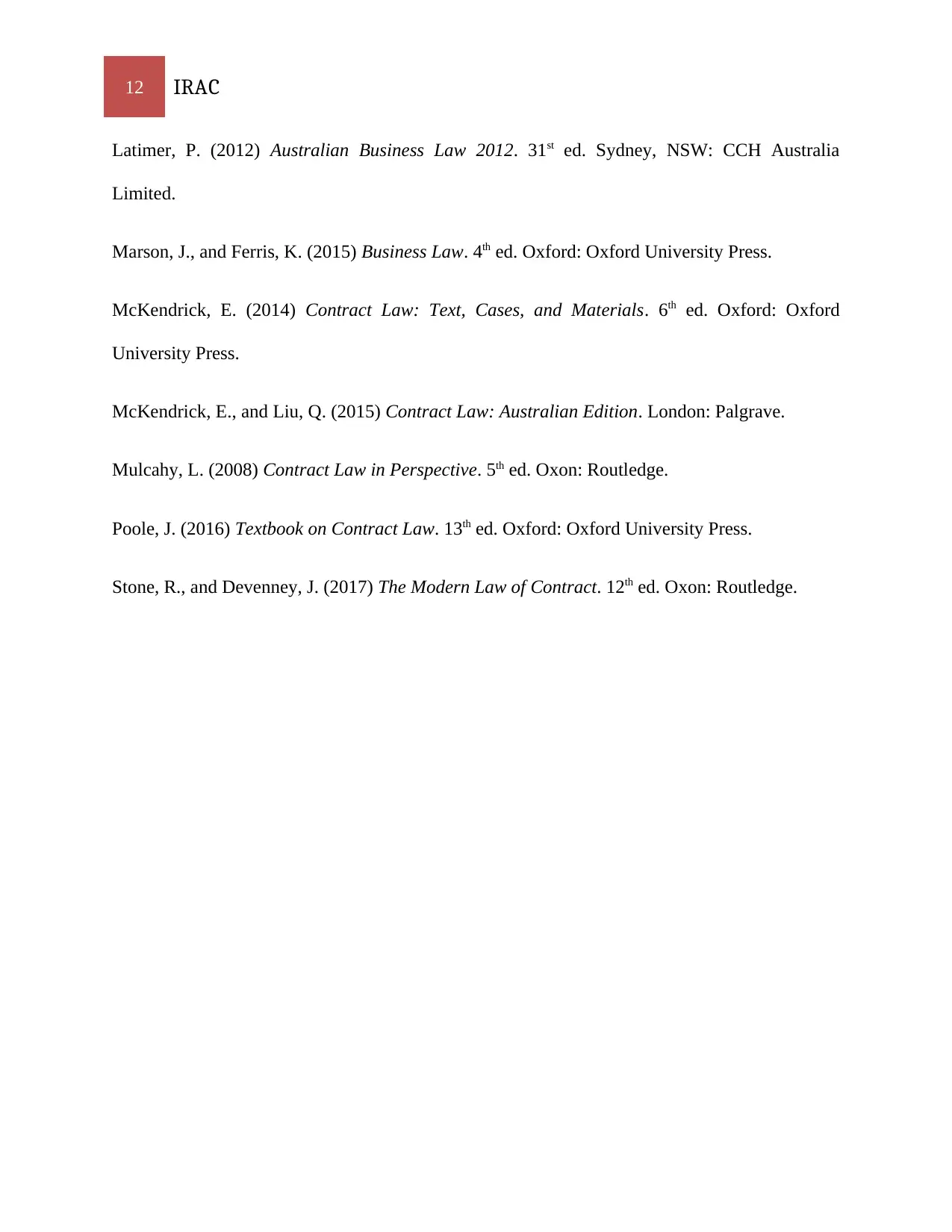
12 IRAC
Latimer, P. (2012) Australian Business Law 2012. 31st ed. Sydney, NSW: CCH Australia
Limited.
Marson, J., and Ferris, K. (2015) Business Law. 4th ed. Oxford: Oxford University Press.
McKendrick, E. (2014) Contract Law: Text, Cases, and Materials. 6th ed. Oxford: Oxford
University Press.
McKendrick, E., and Liu, Q. (2015) Contract Law: Australian Edition. London: Palgrave.
Mulcahy, L. (2008) Contract Law in Perspective. 5th ed. Oxon: Routledge.
Poole, J. (2016) Textbook on Contract Law. 13th ed. Oxford: Oxford University Press.
Stone, R., and Devenney, J. (2017) The Modern Law of Contract. 12th ed. Oxon: Routledge.
Latimer, P. (2012) Australian Business Law 2012. 31st ed. Sydney, NSW: CCH Australia
Limited.
Marson, J., and Ferris, K. (2015) Business Law. 4th ed. Oxford: Oxford University Press.
McKendrick, E. (2014) Contract Law: Text, Cases, and Materials. 6th ed. Oxford: Oxford
University Press.
McKendrick, E., and Liu, Q. (2015) Contract Law: Australian Edition. London: Palgrave.
Mulcahy, L. (2008) Contract Law in Perspective. 5th ed. Oxon: Routledge.
Poole, J. (2016) Textbook on Contract Law. 13th ed. Oxford: Oxford University Press.
Stone, R., and Devenney, J. (2017) The Modern Law of Contract. 12th ed. Oxon: Routledge.
⊘ This is a preview!⊘
Do you want full access?
Subscribe today to unlock all pages.

Trusted by 1+ million students worldwide
1 out of 12
Related Documents
Your All-in-One AI-Powered Toolkit for Academic Success.
+13062052269
info@desklib.com
Available 24*7 on WhatsApp / Email
![[object Object]](/_next/static/media/star-bottom.7253800d.svg)
Unlock your academic potential
Copyright © 2020–2025 A2Z Services. All Rights Reserved. Developed and managed by ZUCOL.





